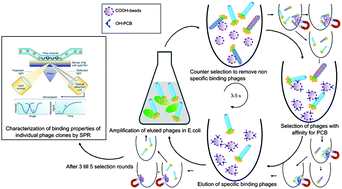In order to assess and avoid risks for both human and environmental health, there is a high need for cost-effective and sensitive detection systems suitable for the monitoring of chemical contaminants in food and the environment. Due to their high sensitivity and selectivity, affinity-based detection systems are interesting for monitoring tools. Antibodies have long been the most popular affinity-based recognition elements, however, recently different novel affinity-based recognition elements with improved characteristics, like specificity, stability and cost-efficiency, have gained attention. In the present study, one type of such novel affinity-based recognition elements, namely landscape phages were evaluated as substitute antibodies for detection of PCB. These phages with affinity for PCBs were selected from a landscape phage library, in which each phage displays an 8-mer peptide at all 4000 major coat proteins pVIII. Landscape phages have potential as biorecognition elements, because of their excellent characteristics, such as high affinity and specificity, fast, cheap and animal-friendly manufacturing process with low batch-to-batch variations and superior stability, which allow them to operate as elements of detector systems in complex environmental and food matrices. Phages with a high specificity for PCB106 were isolated from the landscape phage library. Using surface plasmon resonance (SPR) it was shown that the selected phages bind specifically PCB106 and do not bind PCB72 and PCB118. The dissociation constants (Kd) of the phage binding with PCB106 were in μM range. After further improvement of their binding activity, the specific PCB-binding phages can be used as biorecognition elements for food and environmental monitoring.


 Please wait while we load your content...
Please wait while we load your content...